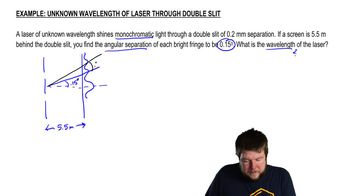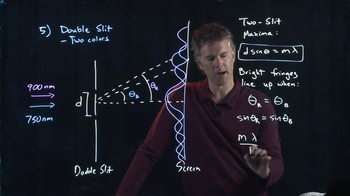34. Wave Optics
Young's Double Slit Experiment
34. Wave Optics
Young's Double Slit Experiment
Additional 2 creators.
Learn with other creators
Showing 5 of 5 videos
Practice this topic
- Multiple Choice
A 450 nm laser shines light through a double slit of 0.2 mm separation. If a screen is placed 4 m behind the double slit, how wide are the bright fringes of the diffraction pattern?
- Multiple ChoiceA 532 nmlaser illuminates a pair of slits separated by . What is the angular separation, in degrees, between the and bright fringes?
- Multiple ChoiceIn a two-slit experiment, laser light of wavelength passes through a pair of slits separated by If the observing screen isfrom the slits, what is the separation, in mm, between the bright fringes?
- Multiple ChoiceA laser illuminates a pair of slits separated by . What is the angular separation, in degrees, between the m = 1 and m = 2 bright fringes?
- Open QuestionA double-slit experiment is set up using a helium-neon laser (λ=633 nm). Then a very thin piece of glass (n=1.50) is placed over one of the slits. Afterward, the central point on the screen is occupied by what had been the m=10 dark fringe. How thick is the glass?
- Open QuestionCoherent light with wavelength 450 nm falls on a pair ofslits. On a screen 1.80 m away, the distance between dark fringesis 3.90 mm. What is the slit separation?
- Open QuestionTwo slits spaced 0.450 mm apart are placed 75.0 cm from a screen. What is the distance between the second and third dark lines of the interference pattern on the screen when the slits are illuminated with coherent light with a wavelength of 500 nm?
- Open QuestionCoherent light of frequency 6.32 * 1014 Hz passes through two thin slits and falls on a screen 85.0 cm away. You observe that the third bright fringe occurs at ±3.11 cm on either side of the central bright fringe. (a) How far apart are the two slits? (b) At what distance from the central bright fringe will the third dark fringe occur?








